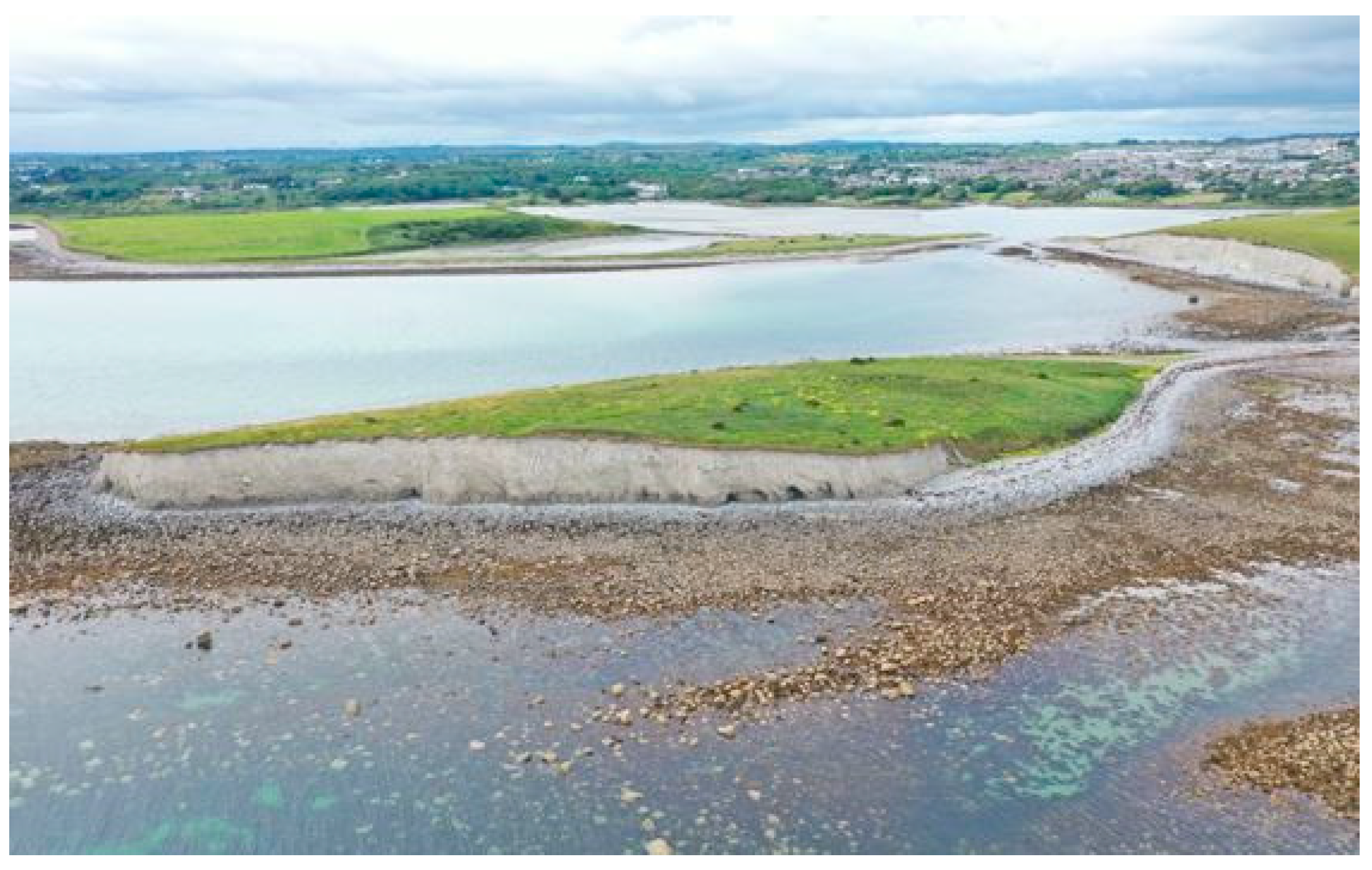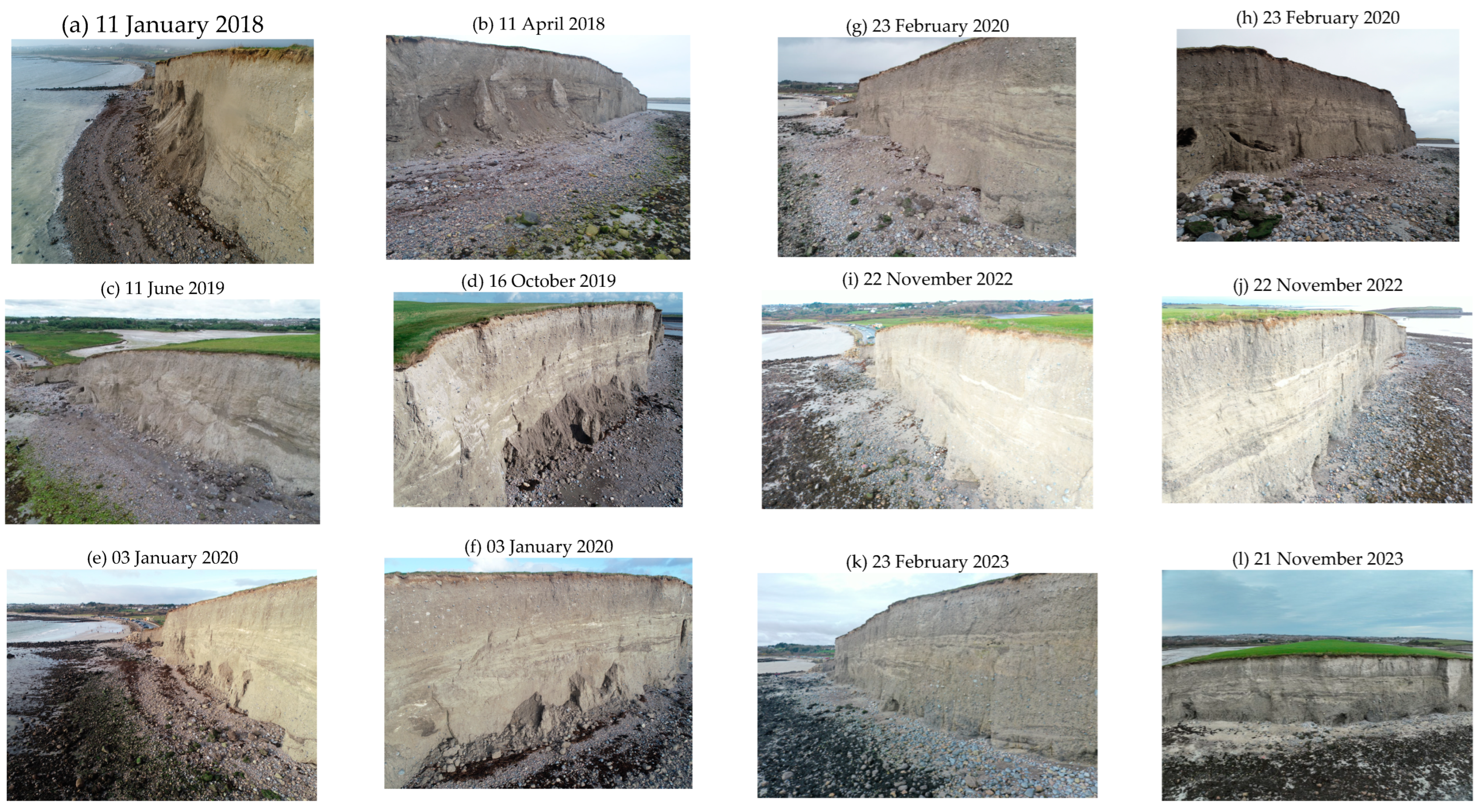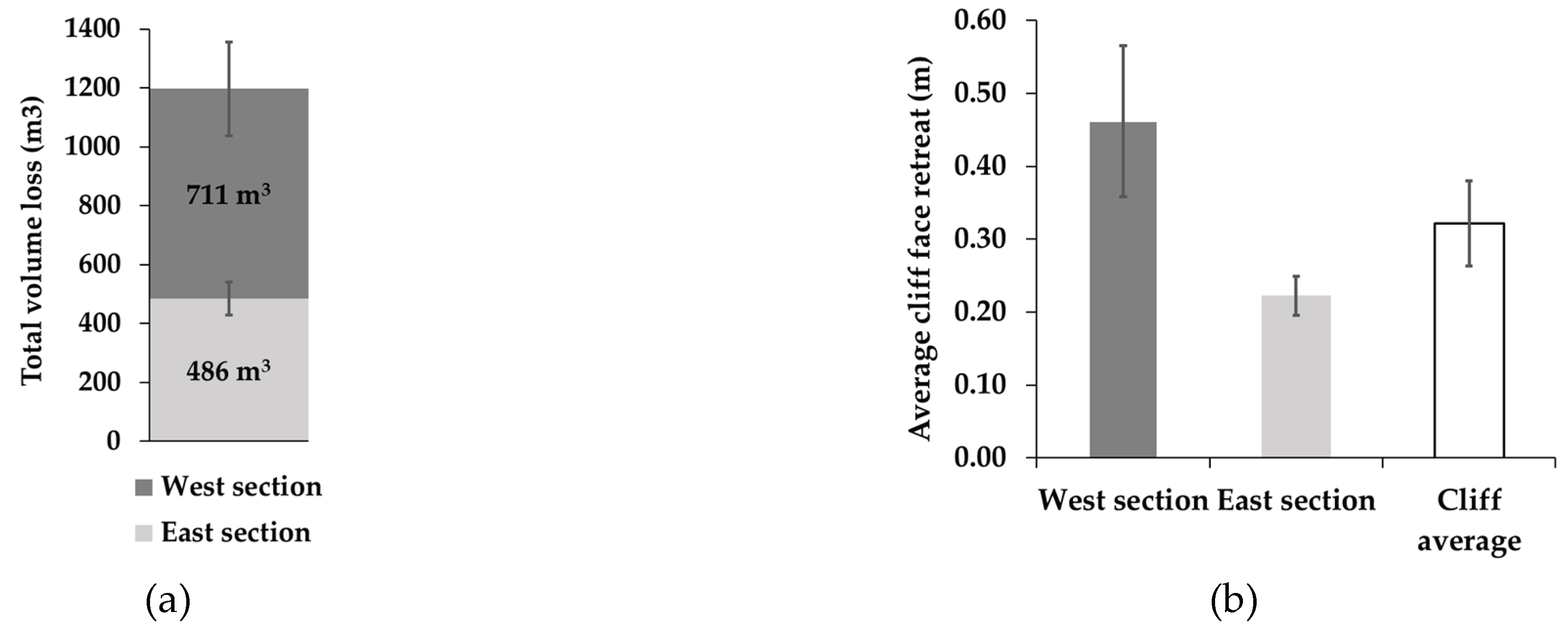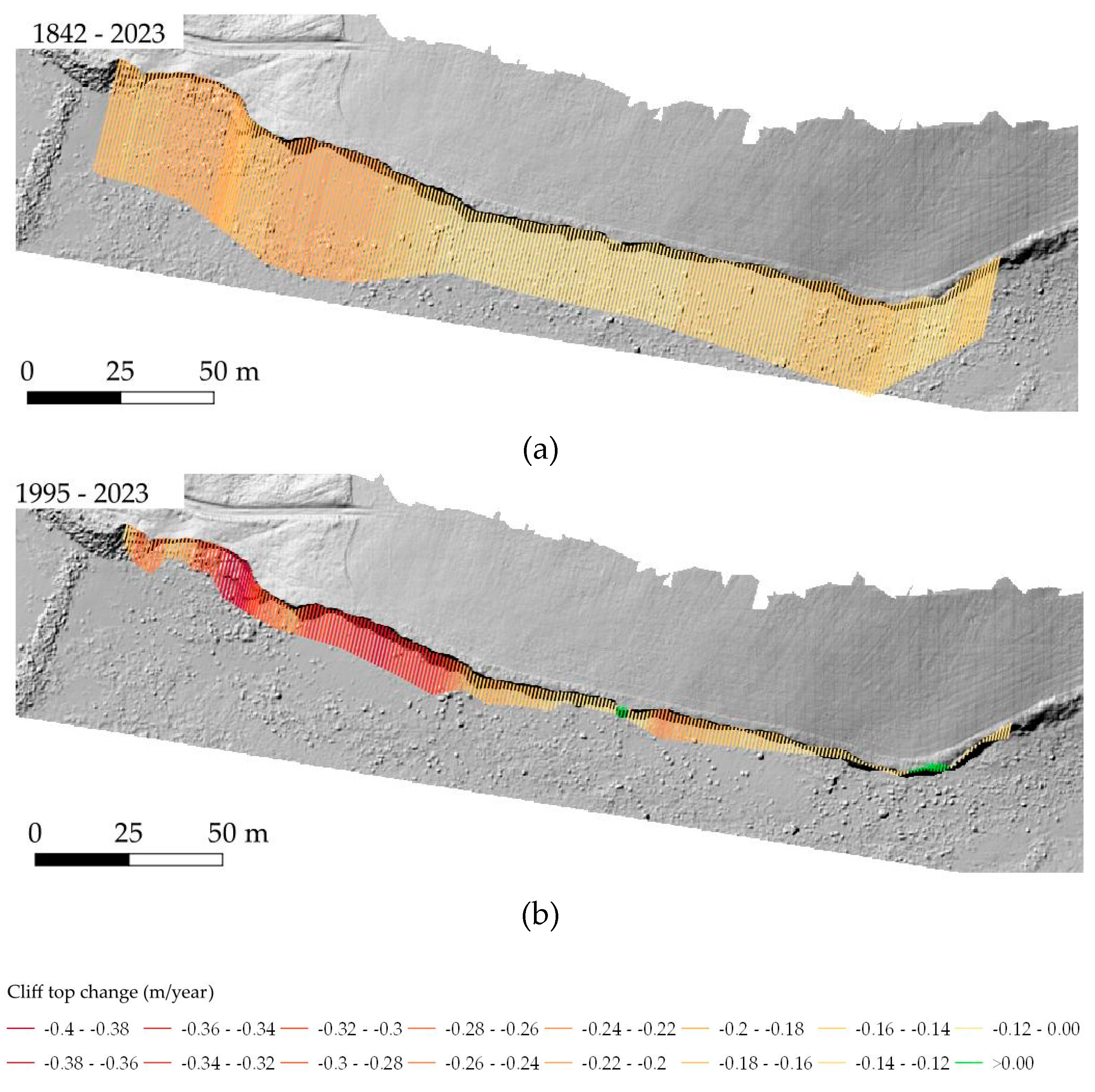Submitted:
08 March 2024
Posted:
10 March 2024
You are already at the latest version
Abstract
Keywords:
1. Introduction
2. Study Site
2.1. Physiographic Setting





2.2. Geological History
3. Materials and Methods
3.1. Structure from Motion
3.1.1. SfM Data Acquisition
3.1.2. SfM Data Processing
3.1.2.1. Computation of PCs and DSMs
3.1.2.2. PC Change Detection
3.1.2.3. Cliff Face: Retreat Rate [m yr-1] and Erosion Rate [m3 yr-1]
3.2. Cliff Top Position
3.2.1. Shoreline Digitization and Error Analysis
3.2.2. Shoreline Changes
3.3. Storm Event Detection
4. Results
4.1. Cliff Face Changes
| Western section | Eastern section | |||
| er [m3 yr-1] | cfr [m yr-1] | er [m3 yr-1] | cfr [m yr-1] | |
| PC-change III | 184 +/-34 | 0.125 +/-0.023 | 102 +/-6 | 0.052 +/-0.003 |
| PC-change IV | 169 +/-59 | 0.111 +/-0.038 | 101 +/-10 | 0.047 +/-0.005 |
| PC-change V | 160 +/-36 | 0.104 +/-0.023 | 109 +/-13 | 0.05 +/-0.006 |
4.3. Cliff Top Changes
4.4. Storm Conditions
5. Discussion
5.1. Cliff Face and Cliff Top Retreat
5.2. Comparison with Previous Studies
6. Conclusions
References
- Knight, J.; Harrison, S. Paraglacial Evolution of the Irish Landscape. IrishGeog 2018, 51, 171–186. [CrossRef]
- Hanvey, P.M. The Sedimentology and Genesis of Late-Pleistocene Drumlins in Counties Mayo and Donegal, Western Ireland. Unpublished DPhil Thesis, University of Ulster, 1988.
- Greenwood, R.O.; Orford, J.D. Temporal Patterns and Processes of Retreat of Drumlin Coastal Cliffs — Strangford Lough, Northern Ireland. Geomorphology 2008, 94, 153–169. [CrossRef]
- McCabe, A.M.; Dardis, G.F. Sedimentology and Depositional Setting of Late Pleistocene Drumlins, Galway Bay, Western Ireland. SEPM JSR 1989, Vol. 59. [CrossRef]
- Department of Housing, Local Government and Heritage and the Office of Public Works Report of the Inter-Departmental Group on National Coastal Change Management Strategy; 2023; p. 108pp;.
- Emery, K.O.; Kuhn, G.G. Sea Cliffs: Their Processes, Profiles, and Classification. Geol Soc America Bull 1982, 93, 644. [CrossRef]
- Prémaillon, M.; Regard, V.; Dewez, T.J.B.; Auda, Y. GlobR2C2 (Global Recession Rates of Coastal Cliffs): A Global Relational Database to Investigate Coastal Rocky Cliff Erosion Rate Variations. Earth Surf. Dynam. 2018, 6, 651–668. [CrossRef]
- Young, A.P.; Carilli, J.E. Global Distribution of Coastal Cliffs. Earth Surf Processes Landf 2019, 44, 1309–1316. [CrossRef]
- Cullen, N. A Study of Rock Coast Erosion on the Atlantic Coast of Ireland, Trinity College Dublin. School of Natural Sciences, 2019.
- Caplain, B.; Astruc, D.; Regard, V.; Moulin, F.Y. Cliff Retreat and Sea Bed Morphology under Monochromatic Wave Forcing: Experimental Study. Comptes Rendus Geoscience 2011, 343, 471–477. [CrossRef]
- Westoby, M.J.; Brasington, J.; Glasser, N.F.; Hambrey, M.J.; Reynolds, J.M. ‘Structure-from-Motion’ Photogrammetry: A Low-Cost, Effective Tool for Geoscience Applications. Geomorphology 2012, 179, 300–314. [CrossRef]
- Gonçalves, J.A.; Henriques, R. UAV Photogrammetry for Topographic Monitoring of Coastal Areas. ISPRS Journal of Photogrammetry and Remote Sensing 2015, 104, 101–111. [CrossRef]
- Luetzenburg, G.; Townsend, D.; Svennevig, K.; Bendixen, M.; Bjørk, A.A.; Eidam, E.F.; Kroon, A. Sedimentary Coastal Cliff Erosion in Greenland. JGR Earth Surface 2023, 128, e2022JF007026. [CrossRef]
- Ruggiero, P.; Kratzmann, M.G.; Himmelstoss, E.A.; Reid, D.; Allan, J.; Kaminsky, G. National Assessment of Shoreline Change: Historical Shoreline Change Along the Pacific Northwest Coast; Open-File Report; U.S. Geological Survey, 2013;.
- Irrgang, A.M.; Lantuit, H.; Manson, G.K.; Günther, F.; Grosse, G.; Overduin, P.P. Variability in Rates of Coastal Change Along the Yukon Coast, 1951 to 2015. J. Geophys. Res. Earth Surf. 2018, 123, 779–800. [CrossRef]
- Rosser, N.J.; Brain, M.J.; Petley, D.N.; Lim, M.; Norman, E.C. Coastline Retreat via Progressive Failure of Rocky Coastal Cliffs. Geology 2013, 41, 939–942. [CrossRef]
- Williams, J.G.; Rosser, N.J.; Hardy, R.J.; Brain, M.J.; Afana, A.A. Optimising 4-D Surface Change Detection: An Approach for Capturing Rockfall Magnitude–Frequency. Earth Surf. Dynam. 2018, 6, 101–119. [CrossRef]
- Swirad, Z.M.; Young, A.P. Spatial and Temporal Trends in California Coastal Cliff Retreat. Geomorphology 2022, 412, 108318. [CrossRef]
- Swirad, Z.M.; Rosser, N.J.; Brain, M.J. Identifying Mechanisms of Shore Platform Erosion Using Structure-from-Motion (SfM) Photogrammetry. Earth Surf. Process. Landforms 2019, 44, 1542–1558. [CrossRef]
- Vanneschi; Camillo; Aiello; Bonciani; Salvini SfM-MVS Photogrammetry for Rockfall Analysis and Hazard Assessment Along the Ancient Roman Via Flaminia Road at the Furlo Gorge (Italy). IJGI 2019, 8, 325. [CrossRef]
- Piermattei, L.; Carturan, L.; Guarnieri, A. Use of Terrestrial Photogrammetry Based on Structure-from-Motion for Mass Balance Estimation of a Small Glacier in the Italian Alps: SfM-MVS APPROACH FOR GLACIER MASS BALANCE ESTIMATION. Earth Surf. Process. Landforms 2015, 40, 1791–1802. [CrossRef]
- Marcer, M.; Stentoft, P.A.; Bjerre, E.; Cimoli, E.; Bjørk, A.; Stenseng, L.; Machguth, H. Three Decades of Volume Change of a Small Greenlandic Glacier Using Ground Penetrating Radar, Structure from Motion, and Aerial Photogrammetry. Arctic, Antarctic, and Alpine Research 2017, 49, 411–425. [CrossRef]
- Colomina, I.; Molina, P. Unmanned Aerial Systems for Photogrammetry and Remote Sensing: A Review. ISPRS Journal of Photogrammetry and Remote Sensing 2014, 92, 79–97. [CrossRef]
- James, M.R.; Robson, S.; d’Oleire-Oltmanns, S.; Niethammer, U. Optimising UAV Topographic Surveys Processed with Structure-from-Motion: Ground Control Quality, Quantity and Bundle Adjustment. Geomorphology 2017, 280, 51–66. [CrossRef]
- James, L.A.; Hodgson, M.E.; Ghoshal, S.; Latiolais, M.M. Geomorphic Change Detection Using Historic Maps and DEM Differencing: The Temporal Dimension of Geospatial Analysis. Geomorphology 2012, 137, 181–198. [CrossRef]
- DaSilva, M.; Miot Da Silva, G.; Hesp, P.A.; Bruce, D.; Keane, R.; Moore, C. Assessing Shoreline Change Using Historical Aerial and RapidEye Satellite Imagery (Cape Jaffa, South Australia). Journal of Coastal Research 2021, 37. [CrossRef]
- Hapke, C.J.; Reid, D. National Assessment of Shoreline Change, Part 4: Historical Coastal Cliff Retreat along the California Coast; U.S. Geological Survey, 2007;.
- Kenny, P. MapGenie. Ordnance Survey Ireland 2023.
- Boardman, J.; Favis-Mortlock, D. Boardman, J. and Favis-Mortlock, D.T. (2016). The Use of Erosion Pins in Geomorphology. Chapter 3.5.3 in Cook, S.J., Clarke, L.E. and Nield, J.M. (Eds) Geomorphological Techniques (Online Edition). British Society for Geomorphology, London, UK. ISSN: 2047-0371. In; 2016 ISBN 2047-0371.
- Young, A.P. Decadal-Scale Coastal Cliff Retreat in Southern and Central California. Geomorphology 2018, 300, 164–175. [CrossRef]
- Sunamura, T. Rocky Coast Processes: With Special Reference to the Recession of Soft Rock Cliffs. Proceedings of the Japan Academy, Series B 2015, 91, 481–500. [CrossRef]
- Gómez-Pazo, A.; Pérez-Alberti, A.; Trenhaile, A. Tracking the Behavior of Rocky Coastal Cliffs in Northwestern Spain. Environ Earth Sci 2021, 80, 757. [CrossRef]
- Utting, D.; Gallacher, A. Coastal Environments and Erosion in Southwest St. Georges Bay, Antigonish County. Mineral Resources Branch Report of Activities 2008, 2009–1.
- Nunes, M.; Ferreira, Ó.; Loureiro, C.; Baily, B. Beach and Cliff Retreat Induced by Storm Groups at Forte Novo, Algarve (Portugal). Journal of Coastal Research 2011, 795–799.
- McKenna, J.; Carter, R.W.G.; Bartlett, D. Coast Erosion in Northeast Ireland:-Part II Cliffs and Shore Platforms. Irish Geography 1992, 25, 111–128. [CrossRef]
- Thébaudeau, B.; Trenhaile, A.S.; Edwards, R.J. Modelling the Development of Rocky Shoreline Profiles along the Northern Coast of Ireland. Geomorphology 2013, 203, 66–78. [CrossRef]
- Cullen, N.D.; Bourke, M.C. Clast Abrasion of a Rock Shore Platform on the Atlantic Coast of Ireland: Clast Abrasion of a Rock Shore Platform. Earth Surf. Process. Landforms 2018, 43, 2627–2641. [CrossRef]
- Benjamin, J. Regional-Scale Controls on Rockfall Occurrence. PhD Thesis, Durham University, 2018.
- Shadrick, J.R.; Hurst, M.D.; Piggott, M.D.; Hebditch, B.G.; Seal, A.J.; Wilcken, K.M.; Rood, D.H. Multi-Objective Optimisation of a Rock Coast Evolution Model with Cosmogenic \chem^10Be Analysis for the Quantification of Long-Term Cliff Retreat Rates. Earth Surface Dynamics 2021, 9, 1505–1529. [CrossRef]
- Shadrick, J.R.; Rood, D.H.; Hurst, M.D.; Piggott, M.D.; Wilcken, K.M.; Seal, A.J. Constraints on Long-Term Cliff Retreat and Intertidal Weathering at Weak Rock Coasts Using Cosmogenic 10 Be, Nearshore Topography and Numerical Modelling. Earth Surf. Dynam. 2023, 11, 429–450. [CrossRef]
- Dornbusch, U.; Robinson, D.A.; Moses, C.A.; Williams, R.B.G. Temporal and Spatial Variations of Chalk Cliff Retreat in East Sussex, 1873 to 2001. Marine Geology 2008, 249, 271–282. [CrossRef]
- Hennessy, R.; Meehan, R.; Gallagher, V.; Parkes, M.; Glanville, C. The Geological Heritage of Galway City. An Audit of County Geological Sites in Galway City; Geological Survey Ireland, 2020;.
- Smith, R. Implications of Proposed Engineering for Soft Rock Coast & Saltmarsh Sediment Dynamics, University of Galway, 2019.
- Peel, M.C.; Finlayson, B.L.; McMahon, T.A. Updated World Map of the Köppen-Geiger Climate Classification. Hydrol. Earth Syst. Sci. 2007, 11, 1633–1644. [CrossRef]
- Fiaschi, S.; Holohan, E.; Sheehy, M.; Floris, M. PS-InSAR Analysis of Sentinel-1 Data for Detecting Ground Motion in Temperate Oceanic Climate Zones: A Case Study in the Republic of Ireland. Remote Sensing 2019, 11, 348. [CrossRef]
- Ren, L.; Nash, S.; Hartnett, M. Observation and Modeling of Tide- and Wind-Induced Surface Currents in Galway Bay. Water Science and Engineering 2015, 8, 345–352. [CrossRef]
- Calvino, C.; Dabrowski, T.; Dias, F. A Study of the Sea Level and Current Effects on the Sea State in Galway Bay, Using the Numerical Model COAWST. Ocean Dynamics 2022, 72, 761–774. [CrossRef]
- Calvino, C.; Dabrowski, T.; Dias, F. A Study of the Wave Effects on the Current Circulation in Galway Bay, Using the Numerical Model COAWST. Coastal Engineering 2023, 180, 104251. [CrossRef]
- Atan, R.; Goggins, J.; Harnett, M.; Agostinho, P.; Nash, S. Assessment of Wave Characteristics and Resource Variability at a 1/4-Scale Wave Energy Test Site in Galway Bay Using Waverider and High Frequency Radar (CODAR) Data. Ocean Engineering 2016, 117, 272–291. [CrossRef]
- Miccadei, E.; Mascioli, F.; Ricci, F.; Piacentini, T. Geomorphology of Soft Clastic Rock Coasts in the Mid-Western Adriatic Sea (Abruzzo, Italy). Geomorphology 2019, 324, 72–94. [CrossRef]
- ESRI Esri Gray (Light) 2021.
- Google Google Satellite 2024.
- Greenwood, S.L.; Clark, C.D. Reconstructing the Last Irish Ice Sheet 1: Changing Flow Geometries and Ice Flow Dynamics Deciphered from the Glacial Landform Record. Quaternary Science Reviews 2009, 28, 3085–3100. [CrossRef]
- Smith, M.J.; Knight, J. Palaeoglaciology of the Last Irish Ice Sheet Reconstructed from Striae Evidence. Quaternary Science Reviews 2011, 30, 147–160. [CrossRef]
- Clark, C.D.; Hughes, A.L.C.; Greenwood, S.L.; Spagnolo, M.; Ng, F.S.L. Size and Shape Characteristics of Drumlins, Derived from a Large Sample, and Associated Scaling Laws. Quaternary Science Reviews 2009, 28, 677–692. [CrossRef]
- Spagnolo, M.; Clark, C.D.; Hughes, A.L.C.; Dunlop, P.; Stokes, C.R. The Planar Shape of Drumlins. Sedimentary Geology 2010, 232, 119–129. [CrossRef]
- Foreman, A.C.; Bromley, G.R.M.; Hall, B.L.; Jackson, M.S. A 10Be-Dated Record of Glacial Retreat in Connemara, Ireland, Following the Last Glacial Maximum and Implications for Regional Climate. Palaeogeography, Palaeoclimatology, Palaeoecology 2022, 592, 110901. [CrossRef]
- Williams, D.M.; Doyle, E. Dates from Drowned Mid-Holocene Landscapes on the Central Western Irish Seaboard. Irish Journal of Earth Sciences 2014, 32, 23–27. [CrossRef]
- O’Connell, M.; Molloy, K. Mid- and Late-Holocene Environmental Change in Western Ireland: New Evidence from Coastal Peats and Fossil Timbers with Particular Reference to Relative Sea-Level Change. The Holocene 2017, 27, 1825–1845. [CrossRef]
- Schettler, G.; Romer, R.L.; O’Connell, M.; Molloy, K. Holocene Climatic Variations and Postglacial Sea-Level Rise Geochemically Recorded in the Sediments of the Brackish Karst Lake An Loch Mor, Western Ireland. Boreas 2006, 35, 674–693. [CrossRef]
- Himmelstoss, E.A.; Farris, A.S.; Henderson, R.E.; Kratzmann, M.G.; Ergul, A.; Zhang, O.; Zichichi, J.L.; Thieler, E.R. Digital Shoreline Analysis System (Version 5) 2018.
- Himmelstoss, E.A.; Henderson, R.E.; Kratzmann, M.G.; Farris, A.S. Digital Shoreline Analysis System (DSAS) Version 5.1 User Guide; Open-File Report; U.S. Geological Survey, 2021;.
- Lague, D.; Brodu, N.; Leroux, J. Accurate 3D Comparison of Complex Topography with Terrestrial Laser Scanner: Application to the Rangitikei Canyon (N-Z). ISPRS Journal of Photogrammetry and Remote Sensing 2013, 82, 10–26. [CrossRef]
- CloudCompare CloudCompare 2022.
- Agisoft LCC Agisoft Metashape User Manual Professional Edition, Version 2.0; 2023;.
- Cullen, N.D.; Verma, A.K.; Bourke, M.C. A Comparison of Structure from Motion Photogrammetry and the Traversing Micro-Erosion Meter for Measuring Erosion on Shore Platforms. Earth Surface Dynamics 2018, 6, 1023–1039. [CrossRef]
- Chen, Y.; Medioni, G. Object Modeling by Registration of Multiple Range Images. In Proceedings of the Proceedings. 1991 IEEE International Conference on Robotics and Automation; 1991; pp. 2724–2729 vol.3.
- Hartmeyer, I.; Keuschnig, M.; Delleske, R.; Krautblatter, M.; Lang, A.; Schrott, L.; Prasicek, G.; Otto, J.-C. A 6-Year Lidar Survey Reveals Enhanced Rockwall Retreat and Modified Rockfall Magnitudes/Frequencies in Deglaciating Cirques. Earth Surf. Dynam. 2020, 8, 753–768. [CrossRef]
- OSI MapGenie WMS 2023.
- Asoni(s), S.G.; Stavrou, A.; Lawrence, J.A. Developing a GIS Based Methodology for Coastal Chalk Cliff Retreat Using Multiple Datasets. In Proceedings of the Engineering in Chalk; ICE Publishing: Imperial College, London, UK, January 2018; pp. 369–374.
- Terres De Lima, L.; Fernández-Fernández, S.; Marcel De Almeida Espinoza, J.; Da Guia Albuquerque, M.; Bernardes, C. End Point Rate Tool for QGIS (EPR4Q): Validation Using DSAS and AMBUR. IJGI 2021, 10, 162. [CrossRef]
- Vallarino Castillo, R.; Negro Valdecantos, V.; Moreno Blasco, L. Shoreline Change Analysis Using Historical Multispectral Landsat Images of the Pacific Coast of Panama. JMSE 2022, 10, 1801. [CrossRef]
- Genz, A.S.; Fletcher, C.H.; Dunn, R.A.; Frazer, L.N.; Rooney, J.J. The Predictive Accuracy of Shoreline Change Rate Methods and Alongshore Beach Variation on Maui, Hawaii. Journal of Coastal Research 2007, 23, 87–105.
- Guisado-Pintado, E.; Jackson, D.W.T. Coastal Impact From High-Energy Events and the Importance of Concurrent Forcing Parameters: The Cases of Storm Ophelia (2017) and Storm Hector (2018) in NW Ireland. Front. Earth Sci. 2019, 7, 190. [CrossRef]
- Zelinsky, D.A. Tropical Cyclone Report: Hurricane Lorenzo (AL132019); United States National Hurricane Center, 2019;.
- Lim, M.; Rosser, N.J.; Allison, R.J.; Petley, D.N. Erosional Processes in the Hard Rock Coastal Cliffs at Staithes, North Yorkshire. Geomorphology 2010, 114, 12–21. [CrossRef]
- Jordan, S.F.; Murphy, B.T.; O’Reilly, S.S.; Doyle, K.P.; Williams, M.D.; Grey, A.; Lee, S.; McCaul, M.V.; Kelleher, B.P. Mid-Holocene Climate Change and Landscape Formation in Ireland: Evidence from a Geochemical Investigation of a Coastal Peat Bog. Organic Geochemistry 2017, 109, 67–76. [CrossRef]
- Williams, J.G.; Rosser, N.J.; Hardy, R.J.; Brain, M.J. The Importance of Monitoring Interval for Rockfall Magnitude-Frequency Estimation. J. Geophys. Res. Earth Surf. 2019, 124, 2841–2853. [CrossRef]
- Brooks, S.M.; Spencer, T.; Boreham, S. Deriving Mechanisms and Thresholds for Cliff Retreat in Soft-Rock Cliffs under Changing Climates: Rapidly Retreating Cliffs of the Suffolk Coast, UK. Geomorphology 2012, 153–154, 48–60. [CrossRef]










| Retreat rate (m/year) | 0.00 – 0.52 | 0.01 – 0.16 | 0.27 – 0.41 | 0.02 – 0.10 | 0.01 – 0.03 | 0.07 +/- 0.043 |
| Methods | Historical maps and aerial photographs | Erosion pins | Historical maps and aerial photographs | Airborne LiDAR | Cosmogenic nuclide analysis and coastal evolution modelling | Historical maps |
| Cliff length | Not reported | Not reported | 23 km | 20.459 km | Not reported | ~ 5.5 km |
| Number of cliffs | 5 | 16 | 5 | 2 | 1 | 1 |
| Study period (years) | 156 | 3 | 128 | 3 | Not reported | 122 |
| Age | Holocene | Holocene | Cretaceous | Jurassic | Carboniferous | Cretaceous |
| Cliff lithology | Till | Till | Chalk | Sandstone, mudstone |
Sandstone, mudstone |
Chalk |
| Region | Portballintrae, UK |
Strangford Lough, UK |
E Sussex, UK |
N Yorkshire, UK |
Bideford, UK |
St. Margarets, UK |
| Study | McKenna et al. 1992 | Greenwood & Orford 2008 | Dornbusch et al. 2008 | Benjamin 2018 | Shadrick et al. 2021 | Shadrick et al. 2023 |
| Data source | Date | Feature | UAV model | Images collected | GCPs |
|---|---|---|---|---|---|
| OSI 6”map | 1842 | Cliff top | |||
| OSI orthophoto | 1995 | Cliff top | |||
| OSI orthophoto | 2000 | Cliff top | |||
| UAV | 11/06/2019 | Cliff face | DJI Phantom 4 Pro | 118 | 6 |
| UAV | 02/10/2019 | Cliff face | DJI Phantom 4 Pro | 257 | 9 |
| UAV | 05/10/2019 | Both | DJI Phantom 4 Pro | 185 | 5 |
| UAV | 22/11/2022 | Cliff face | DJI Mavic 2 Pro | 321 | 9 |
| UAV | 21/09/2023 | Both | DJI Mavic 3M | 348 | 5 |
| UAV | 21/11/2023 | Cliff face | DJI Mavic 3M | 513 | 9 |
| Time period | Reference survey date | Comparison survey date | Duration between surveys (days) |
|---|---|---|---|
| PC-change I | 11/06/2019 | 02/10/2019 | 1260 |
| PC-change II | 11/06/2019 | 05/10/2019 | 1563 |
| PC-change III | 11/06/2019 | 22/11/2022 | 1624 |
| PC-change IV | 11/06/2019 | 21/09/2023 | 113 |
| PC-change V | 11/06/2019 | 21/11/2023 | 116 |
| Time period | Reference date | Analysed date |
|---|---|---|
| DSAS I | 1842 | 01/01/2000 |
| DSAS II | 1842 | 05/10/2019 |
| DSAS III | 1842 | 21/09/2023 |
| DSAS IV | 1995 | 21/09/2023 |
| # Storms | Hs Average (m) |
Hs Max (m) |
Direction ° |
Duration Average (hrs) |
|
| Winter | 21 | 3.15 | 5.44 | 322 | 95 |
| Spring | 5 | 3.06 | 5.32 | 323 | 62 |
| Summer | 0 | ||||
| Autumn | 4 | 2.89 | 4.84 | 325 | 61 |
| ctr (m/year) |
0.14 +/- 0.01 | 0.12 +/- 0.19 | 0.03 +/- 0.16 | 0.17 +/- 0.09 | 0.36 +/- 0.03 | cliff top retreat rate |
0.07 +/- 0.04 | 0.70 +/- 0.20 | 0.51 +/- 0.24 | 1.20 +/- 0.80 | 0.23 +/- 0.25 | |
| cfr(m/year) | 0.08 +/- 0.01 | 0.07 +/- 0.04 | 0.03 +/- 0.08 | 0.05 +/- 0.13 | cliff face retreat rate | |||||||
| Methods | SfM and historical maps and aerial images | Erosion pins 0.5m above cliff base | Airborne LiDAR | Airborne LiDAR | historical maps and aerial photographs |
historical maps and aerial photographs |
Methods | historical maps |
Airborne LiDAR and historical maps | Historical images | Airborne LiDAR and UAV | Statistical comparison of previous studies |
| total studied cliff length |
~ 250 m | ~ 120 km | ~ 120 km | 23 km |
total studied cliff length |
~ 5.5 km |
~ 154 km | ~ 200m | ~ 400 m | |||
| Number of cliffs |
1 | 16 | 1 | 1 | 5 |
5 | Number of cliffs |
1 | 1 | 2 | 1 | 403 |
| Study period | 181 | 3 | 11.5 | 5-7 | 156 |
128 |
Study period | 122 |
70 | 58 | 0.25-0.36 | |
| Age | Holocene | Holocene | Pleistocene | Pleistocene | Holocene |
Cretaceous |
Age | Cretaceous |
Quaternary | Holocene | Pliocene - Pleistocene | |
| Cliff lithology | Till | Till | Base: consolidated mudstones-sandstones Top: weak consolidated sandstone-mudstone |
Base: consolidated mudstones-sandstones Top: weak consolidated sandstone-mudstone |
Till |
Chalk |
Cliff lithology | Chalk |
Unconsolidated Quaternary | Till | Poorly to non-consolidated red sands and sandstones | Weak rock general |
| Region | Galway Bay, IRE | Strangford Lough, UK | S California, USA | S California, USA | Portballintrae, UK |
E Sussex, UK |
Region | St. Margarets, UK |
Eureka, USA | St. Georges Bay, CAN | Forte Novo, POR | Global |
| Study | This study | Greenwood & Orford 2008 | Young 2018 | Swirad & Young 2022 | McKenna et al. 1992 |
Dronbusch et al. 2008 |
Study | Shadrick et al. 2023 |
Hapke & Reind 2007 | Utting & Gallacher 2008 | Nunes et al. 2011 | Premaillon et al. 2018 |
Disclaimer/Publisher’s Note: The statements, opinions and data contained in all publications are solely those of the individual author(s) and contributor(s) and not of MDPI and/or the editor(s). MDPI and/or the editor(s) disclaim responsibility for any injury to people or property resulting from any ideas, methods, instructions or products referred to in the content. |
© 2024 by the authors. Licensee MDPI, Basel, Switzerland. This article is an open access article distributed under the terms and conditions of the Creative Commons Attribution (CC BY) license (http://creativecommons.org/licenses/by/4.0/).





